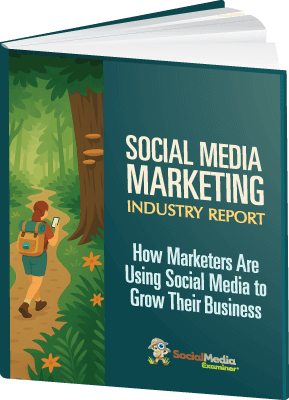Are you struggling to generate qualified leads from your LinkedIn content? Wondering how to transform your social media presence into a revenue-driving machine?
In this article, you'll discover how to create strategic LinkedIn content that converts prospects into qualified leads using a proven formula that generated $10K in pipeline in just eight days.
Why LinkedIn Works for Marketers
LinkedIn stands apart from other social media platforms because it is fundamentally networking-first. Unlike Facebook, Instagram, TikTok, and YouTube, which are primarily content-heavy platforms focused on entertainment, LinkedIn was literally built to create relationships among business professionals.
This creates a unique advantage for marketers. When you create strategic content on LinkedIn, conversations start faster and easier than on other social media networks because the platform's entire purpose is professional networking and relationship building.
Personal profiles receive three to four times more reach than company pages on LinkedIn. The platform openly acknowledges this and it’s because people do business with people, not logos or company pages. This doesn't mean you should neglect your company page, but you should focus on leveraging the humans within your organization and encouraging them to build their personal brands.
At the same time, there’s been a shift in LinkedIn's algorithm: the platform now shows posts much later in the lifecycle than before, sometimes surfacing content from two weeks ago organically without any advertising spend.
Mandy McEwen, LinkedIn expert and founder of Luminetics, recently experienced this power firsthand. After posting strategically for over a decade, she and her team developed a specific type of repeatable post format focused on problem-solution content. A single post led to $10,000 in pipeline within approximately eight days.
The Niche Problem Post Formula for Strategic Lead Generation on LinkedIn
The core of this lead generation strategy revolves around what McEwen calls niche problem posts. These posts follow a specific structure designed to get prospects nodding their heads in recognition, thinking “That's me” as they read.
The format breaks down to approximately 80% problem identification and 20% solution presentation. The primary goal is getting prospects to have that emotional recognition moment where they see themselves clearly reflected in the problem you're describing.
Focus on one niche problem post per week if you're posting five times weekly, or increase the frequency to one in three if you post less often. These shouldn't comprise your entire content strategy—mix them with personal stories, industry insights, and lighter content that shows your human side.
Before implementing any content strategy, you must establish crucial foundational elements. Everything else will fail without these fundamentals in place.
First, you need to know your ideal customer profile inside and out. This goes beyond basic demographics to understanding what keeps them awake at night and their specific pain points. You need to be crystal clear on who your perfect customer is, what challenges they face, and what drives their decision-making.
An effective method for gathering this intelligence involves using AI tools to analyze your customer interactions. Take transcripts from all your past sales calls and customer conversations, then feed them into your preferred AI tool. Ask the AI to identify common themes, frequently asked questions, biggest pain points and challenges, and patterns that emerge consistently across conversations.
Second, your LinkedIn profile must speak directly to that ideal customer. Transform your profile into a mini landing page that clearly communicates the value you provide to people and businesses like them, along with the results you've achieved for similar clients. This isn't about showcasing how amazing you are—it's about demonstrating exactly how you help people like your prospects and why they should trust you. Back this up with case studies, testimonials, and concrete evidence of your expertise.
Ready to Supercharge Your Marketing Strategy?
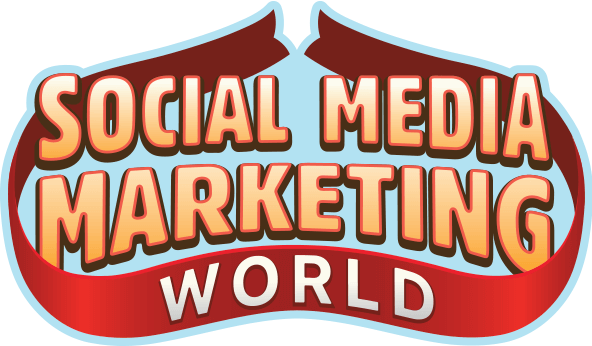
Get expert training and an unbeatable conference experience when you attend Social Media Marketing World—from your friends at Social Media Examiner.
Broaden your reach, skyrocket your engagement, and grow your sales. Become the marketing hero your company or clients need!
🔥 Save $850 on an All-Access ticket. Sale Ends Tuesday! 🔥
GET THE DETAILSFinally, you need a legitimate, proven offer and a sales funnel to move prospects through your process. This means having an offer that people have actually purchased before, something tested and proven to work, along with a systematic way to guide prospects from initial interest to final purchase.
#1: How to Format and Style Niche Problem Posts
These niche problem posts work best as text-only content without images or videos, so prospects focus entirely on the message without visual elements pulling their attention away.
Keep your posts between 300-350 words on average. While this might seem long for social media, it's necessary to properly develop the problem-symptom-solution sequence.
Dense text blocks perform poorly on mobile devices, where most LinkedIn consumption happens, so each major point should have visual separation to improve readability and comprehension. Break the post content into short paragraphs, often just one or two sentences each, to make skimming easy on mobile devices.
Bold any key phrases and bullet points to help important information stand out when people skim. Since LinkedIn doesn't provide native formatting options, you can search for a LinkedIn text formatter or use sites like LingoJam to generate formatted text you can paste into your posts.
In your post, use the language your ideal customers actually use. Don't use your internal jargon or marketing speak—use the exact phrases and words your prospects use when describing their challenges.
McEwen's team developed its approach by analyzing sales call transcripts and customer conversations to identify patterns. They spent hours dissecting this information with AI, having back-and-forth conversations to refine their understanding. This wasn't a quick five-minute process—it required substantial time investment working with team members to go through findings line by line, testing different approaches, and iterating on the messaging.
For example, in targeting sales teams struggling with cold outreach, they identified “spray and pray” as a universally recognized problem term in that industry. Everyone in sales knows what spray and pray means—blasting out generic messages without targeting or personalization. They could then frame posts around this familiar concept while introducing their own terminology for the solution.
Pro Tip: If you’re using AI to create your ad copy, this requires telling your AI tools specifically to use the exact same words and phrases that your customers use. If you don’t, the AI will paraphrase and return imprecise language.
#2: Develop Your Niche Problem Hook
The opening of your niche problem post needs a strong hook that immediately captures attention and establishes the problem framework. McEwen's team tested multiple variations of the same core message with different hooks.
Examples of effective hooks include direct problem statements like “Your sales team's cold outreach is getting harder,” followed by supporting evidence such as “Open rates are dropping. Replies are rare.” You could also use contrarian statements like “Cold outbound isn't dead, but it's definitely on life support” to challenge common assumptions while acknowledging the real struggle.
Another approach identifies what people think they're doing right: “Most sales teams think they're scaling outbound, but they're really scaling more noise and less relevance.” This pattern works because it acknowledges their good intentions while pointing out the unintended consequences.
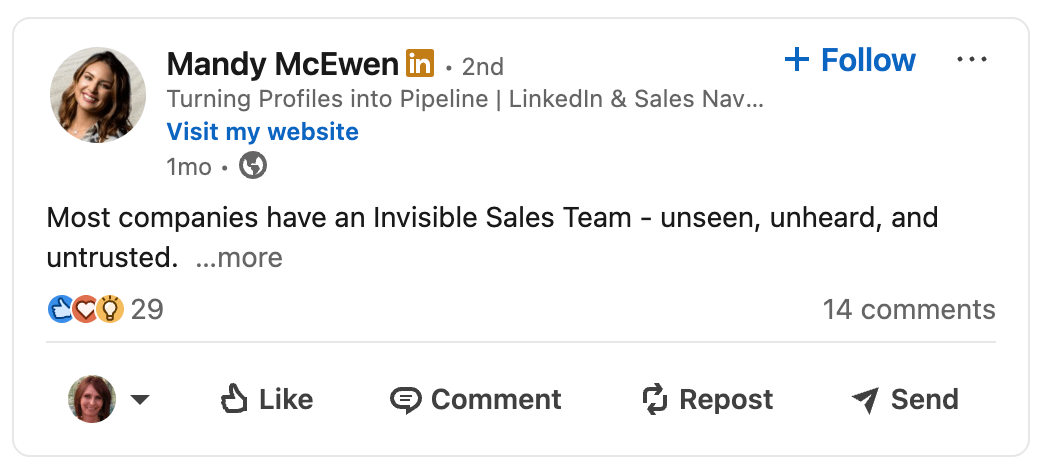
You’ll want to test different ways to say essentially the same thing. Each hook should represent a slightly different angle on the same underlying problem, allowing you to see which resonates most strongly with your specific audience while building a library of proven approaches.
#3: Detail the Symptoms of the Niche Problem
After establishing the problem hook, you need to detail what the problem actually looks like in practice. This symptoms section helps prospects recognize their exact situation by painting a detailed picture of how the problem manifests day-to-day.
For the sales outreach example, symptoms might include reps blasting templated emails to long, untargeted lists, sprinkling in superficial personalization like “saw you brought in a new CRO” that feels fake because literally everyone is doing that with AI tools now, sending messages with zero context or relationship where buyers don't recognize the sender, having messages marked as spam or ignored completely, and prospects who do open emails checking LinkedIn profiles only to find someone with no credibility or presence.
List three to five specific symptoms, keeping each one short and immediately recognizable. These should be direct observations about what's happening, not lengthy explanations. The goal is rapid-fire recognition where prospects think “yes, yes, yes” as they read each point.
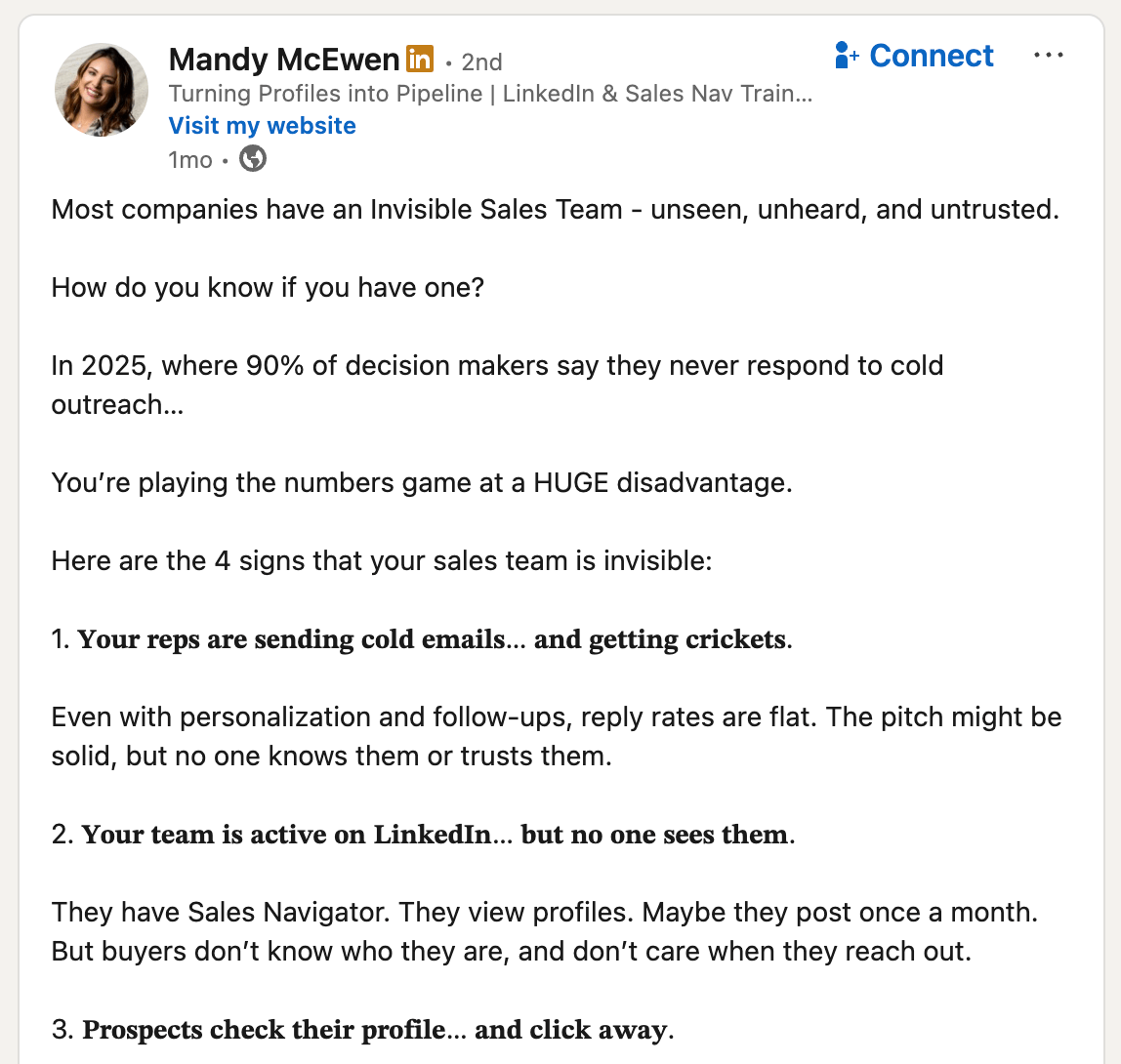
Use the exact language your prospects use when describing these situations. If they say “no one's opening our emails,” use that phrase rather than “low open rates.” If they complain about “standing out,” use those words instead of “differentiation challenges.” This authentic language creates a stronger emotional connection than polished marketing terminology.
#4: Name the Real Niche Problem
After detailing symptoms, introduce the underlying issue with a name that encapsulates the entire situation. This isn't necessarily communicated with a term they already know; it's your reframing of their scattered symptoms into a cohesive problem.
AI Is No Longer Optional for Marketers—Ready to Master It?

Join over a thousand forward-thinking marketers at AI Business World—a conference-in-a-conference at Social Media Marketing World.
Get two days of practical AI training where you'll discover:
✅ Systems that 3x your output—leaving time for strategy and creativity
✅ Proven strategies you can deploy right away—no guesswork, no wasted budget
Become the indispensable AI expert your company needs.
GET YOUR TICKETS—SAVE $350McEwen's team called out the invisible sales team problem. They spent considerable time developing this terminology, brainstorming different ways to capture the essence of sales reps who aren't visible to prospects, don't have credibility when prospects research them, and essentially disappear into the noise of generic outreach.
The naming serves multiple purposes. It provides instant credibility because you're demonstrating deep understanding by giving their complex situation a simple, memorable label. It also makes you look like an expert who has seen this pattern before and knows how to address it.
Keep these names short—three to four words maximum—because you'll repeat them throughout your messaging. Longer phrases become cumbersome and less memorable. The name should be immediately intuitive without requiring explanation, so prospects instantly understand what you mean without having to think about it.

You can create names for problems even when addressing well-known issues. While everyone might understand algorithm suppression, you could introduce “promotional trap” as your terminology for how businesses get caught in patterns that trigger algorithm penalties. This gives you ownership of the concept while building on familiar foundations.
#5: Introduce Your Niche Problem Solution
Once you've established and named the problem, transition into your solution approach. This section should feel like natural problem-solving advice rather than a sales pitch. You're essentially giving prospects a roadmap for addressing their situation, which happens to align with what your service provides.
Start with a bridge phrase like “That's why we built the Modern Social Seller system” or “That's why you need an algorithm-buster strategy.” The solution name should be broad enough that others could use similar terminology; avoid using your trademarked product name, which immediately signals sales intent.
Present your solution as a series of outcomes or changes that need to happen. For the sales team example, this might include reps building buyer-facing profiles that create credibility, showing up strategically before and after outreach so they're recognized when it matters, posting useful content that demonstrates understanding of prospect challenges, and generating genuine human conversations instead of getting ghosted.
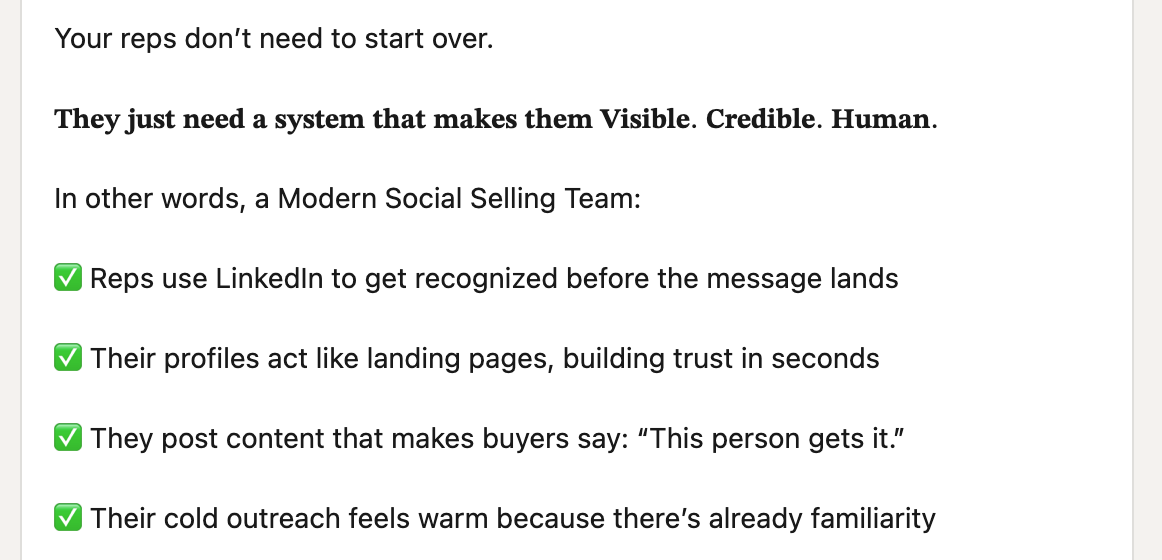
This model works because you're teaching them what needs to happen to solve their problem. They could potentially implement this guidance themselves, work with you, or find another provider—but you've positioned yourself as the expert who understands both the problem and solution architecture.
Pro Tip: Use language focused on desired outcomes rather than features or processes. Instead of “we provide LinkedIn training,” describe results like “reps build profiles that create instant credibility” or “outreach generates genuine conversations instead of silence.”
#6: Provide Social Proof
Before presenting your call to action, include specific evidence that your approach works. This social proof section bridges the gap between your solution framework and asking for action.
By providing multiple examples that demonstrate consistent results across different situations. This shows your approach isn't dependent on unique circumstances but works reliably when implemented properly.
Share concrete results with specific numbers and timeframes.

McEwen includes examples like “With this system in place, open rates improve, reply rates improve, sales cycles shorten. One team hit 120% of quota consistently quarter after quarter, one sales team tripled pipeline and created a culture of accountability, another got three new clients.”
Include variety in your proof points. Some prospects respond to percentage improvements, others to absolute numbers, and still others to competitive achievements. By including different types of evidence, you increase the likelihood of resonating with various decision-making styles.
Focus on business outcomes your prospects care about rather than process metrics. Revenue increases, quota achievement, pipeline growth, and client acquisition matter more than training completion rates or profile optimization scores.
#7: Deliver Your Call to Action
End with a clear, specific call to action that removes barriers to taking the next step. You have two primary approaches: direct message requests or landing page links.
The call to action should feel like a natural next step rather than an abrupt sales pitch. You've identified their problem, shown you understand the symptoms, provided a solution framework, and demonstrated results—now you're simply offering to help them implement what you've outlined.
For direct messages, use specific language like “Send me a message if you want to see a fifteen-minute demo of how this can work for your team.” This creates a low-commitment way for prospects to express interest while qualifying themselves through the act of reaching out.
For landing pages, frame the link as valuable information: “Here's how to plug this system into your current workflow” leading to a detailed page that expands on your post content with more testimonials, case studies, and program details.
When using links in posts, accept that reach may decrease slightly compared to posts without external links. However, for lead generation posts, putting the link directly in the content performs better than asking people to find it in comments. Most people won't scroll through comments to find your link, so the slight reach reduction is worth the improved conversion.
Mix up your calls to action to test what works best with your audience. Some prospects prefer direct communication, while others want to research thoroughly before engaging. Providing both options over time accommodates different decision-making preferences.
Implement the Niche Problem Post Strategy
Successful implementation requires treating this as a systematic process rather than a one-off tactic. Start by conducting thorough research using your sales call transcripts and customer conversation records. This foundational work determines everything else, so invest adequate time in understanding your prospects' exact language and pain points.
Develop multiple variations of your core message with different hooks and symptom descriptions. This allows you to test different approaches while maintaining consistent messaging about the underlying problem and solution. Create a library of 8-10 posts following this format so you can maintain consistency over time.
Track meaningful metrics beyond engagement numbers. Monitor profile visits from your target audience, direct messages from qualified prospects, landing page conversions, and mentions of your content in sales conversations. These indicators matter more than likes or comments for lead generation purposes.
Plan to use successful organic posts as LinkedIn ads. The posts that generate strong organic responses often perform well as promoted content, extending their reach to new audiences who haven't discovered your profile yet. This dual-purpose approach maximizes the return on your content creation investment.
Remember that these lead generation posts should complement, not replace, other content types. Continue sharing industry insights, personal stories, and valuable tips that build your overall personal brand. The niche problem posts work because they're supported by a broader content strategy that establishes your expertise and personality.
Success with this approach requires patience and consistency. Some prospects who respond may have been following you for years without engaging, and are finally motivated to reach out by this specific type of content. Others discover you for the first time through these posts. Both warm and cold lead generation happen simultaneously when you execute this strategy effectively.
Mandy McEwen is a LinkedIn expert and founder of Luminetics, a LinkedIn training company that helps sales and marketing teams drive visibility and revenue. Her forthcoming podcast is Your Future Business. Follow her on LinkedIn and YouTube.
Other Notes From This Episode
- Connect with Michael Stelzner @Stelzner on Instagram and @Mike_Stelzner on X.
- Watch this interview and other exclusive content from Social Media Examiner on YouTube.
Listen to the Podcast Now
This article is sourced from the Social Media Marketing Podcast, a top marketing podcast. Listen or subscribe below.
Where to subscribe: Apple Podcasts | Spotify | YouTube Music | YouTube | Amazon Music | RSS
✋🏽 If you enjoyed this episode of the Social Media Marketing podcast, please head over to Apple Podcasts, leave a rating, write a review, and subscribe.
Stay Up-to-Date: Get New Marketing Articles Delivered to You!
Don't miss out on upcoming social media marketing insights and strategies! Sign up to receive notifications when we publish new articles on Social Media Examiner. Our expertly crafted content will help you stay ahead of the curve and drive results for your business. Click the link below to sign up now and receive our annual report!
AI Is Transforming Marketing—Are You Keeping Up?
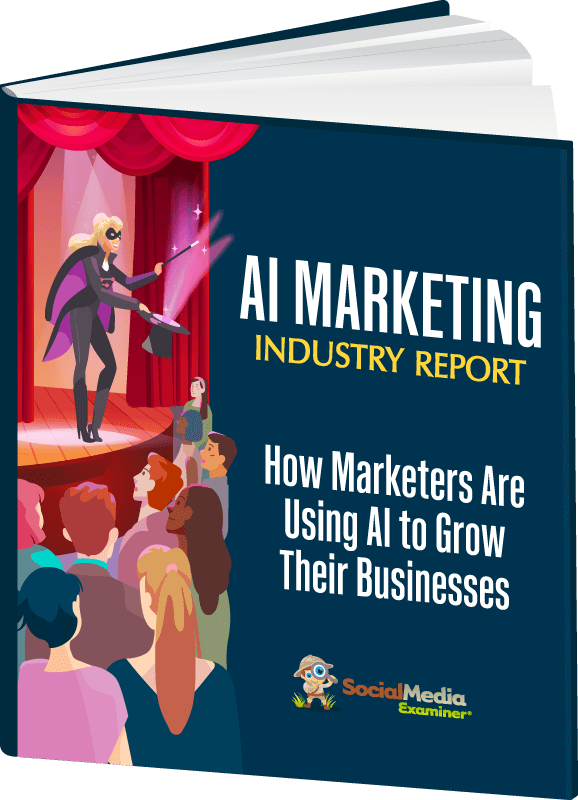
Marketers are rapidly adopting AI to transform their work. Our new 2025 AI Marketing Industry Report surveyed over 730 marketers to reveal the tools, tactics, and trends shaping the industry, including
🔥 90% of marketers save time with AI—discover the top use cases
🔥 The 5 biggest challenges marketers face with AI and how to overcome them
GET THE AI MARKETING INDUSTRY REPORT
